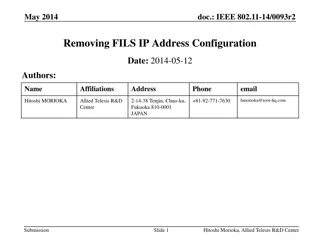
Fair Pricing Principles in Drug Development
Explore the concept of fairness in drug pricing, examining the relationship between public contributions and pricing integrity. Delve into questions of government obligations, comparative pricing, and transactional fairness. Discuss the principle of proportionality as a tool for ensuring equitable distribution of benefits in drug development. Consider the potential implications of incorporating proportionality into existing laws like MDPNP.
Download Presentation

Please find below an Image/Link to download the presentation.
The content on the website is provided AS IS for your information and personal use only. It may not be sold, licensed, or shared on other websites without obtaining consent from the author. If you encounter any issues during the download, it is possible that the publisher has removed the file from their server.
You are allowed to download the files provided on this website for personal or commercial use, subject to the condition that they are used lawfully. All files are the property of their respective owners.
The content on the website is provided AS IS for your information and personal use only. It may not be sold, licensed, or shared on other websites without obtaining consent from the author.
E N D
Presentation Transcript
What We Are Owed Forthcoming in Conn. L. Rev. January 2026 Rebecca Wolitz Assistant Professor of Law Moritz College of Law
Three questions 1. What do people mean when they claim that a drug s price is unfair in light of public contributions? 2. Is there an underlying principle here worth taking seriously? 3. How can (should?) we operationalize this principle within existing law (MDPNP)? Note: Focusing on the linkage between public funding and the fairness of drug pricing DOES NOT mean there aren t issues of fair pricing for a drug REGARDLESS of funding lineage.
Possible kinds of unfairness 1. (Unmet) government obligations to ensure access to medications 2. Comparative unfairness with foreign prices 3. Transactional unfairness
A principle of proportionality Based on the idea of moral desert The value of the benefits each party derives from a joint enterprise (when there are benefits to distribute) ought to be calibrated to (proportional) to the value of each party s respective contributions Familiar idea in theory and in law
Proportionality as a Default Intrinsic and instrumental reasons in favor Proportionality demonstrates a commitment to fairness Could improve accountability and transparency Provides a forcing function puts explanatory onus on those who would deviate from proportional returns Could improve public trust in the government as a worthy steward of scarce taxpayer resources (e.g. isn t being wasteful or taken advantage of) Incremental and flexible
Implementation Lots of open questions that require additional exploration While it legally could, what role for proportionality within the MDPNP? Perhaps best viewed as a back-stop. Prior federal funding just one of many factors Unclear that in-kind benefits of price concessions best captures what public is owed MDPNP s purpose is to negotiate fair prices for Medicare, not procure what the public is owed by way of contributions to R&D Perhaps could pilot aspects of implementation
Thank you! Wolitz.1@osu.edu
Implementation Questions Policymakers must engage with the following issues: (1) What exactly must be proportional? (2) What ought to count as a contribution for determining a party s relative investments? (3) What ought to count as a benefit for determining a party s relative returns? (4) How can a principle of proportionality respect considerations of fairness while not undermining concerns for innovation incentives? (5) In what way ought drug-pricing concessions or affordability concerns figure into the form a return to the government ought to take? (6) How might proportionality be incorporated into the existing legal regime and what institutional complexities might it encounter?
Determining the Maximum Fair Price Drug manufacturer negotiates with the Secretary a maximum fair price Secretary shall consider a number of factors based on: manufacturer-specific data evidence of alternative treatments Ceiling on the offer: the lower of certain prices for Part B and D and the non-federal average price (non-FAMP) Ranges from 40-75% depending on how old the drug is Older drugs, have a lower maximum price






